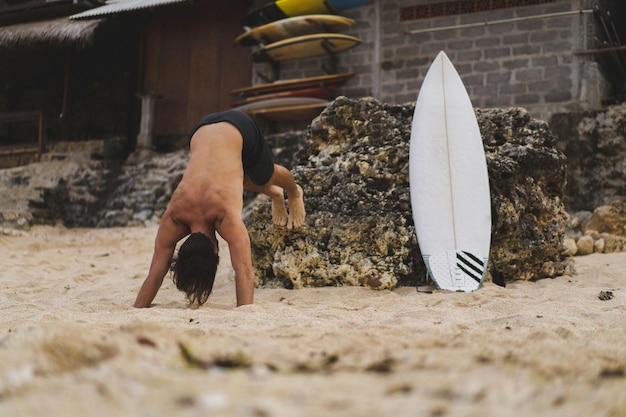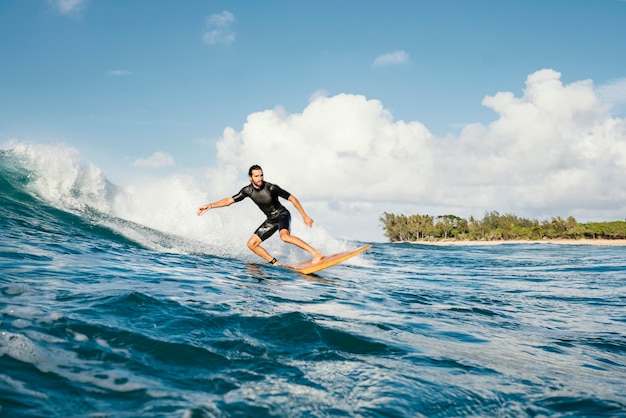Surfing is a way of life, not only a sport. It is immensely fulfilling because of the excitement of riding waves, the relationship with nature, and the sense of success. However, mastering the sport requires commitment, repetition, and knowledge of its difficulties.
This blog will offer insightful information regardless of your experience level—beginner seeking to advance or expert surfer hoping to master advanced methods. We’ll review basic skills, training advice, and typical challenges surfers encounter on their path to proficiency. Get diving in and learn how to surf professionally.
Learning the Basics
Selecting the Appropriate Surfboard

Making advancement depends on selecting the correct surfboard. Starting with a longboard would help beginners to develop better stability and simpler paddling. Usually nine feet or longer, longboards give a steady foundation for learning. You may move better on shorter boards as you go. For seasoned surfers, shortboards are perfect since they are more responsive and allow for more exact turns.
Learning to Ride
A basic ability of surfing is paddling. Good paddling lets you position yourself properly and catch waves. In calm seas, practice paddling with an eye toward fluid, forceful strokes. Pull across the water with your whole arm to maintain body balance on the board. Regularity will increase your stamina and help you to catch waves more easily.
Pop-up Method

The pop-up is the action that converts reclining on your board into standing. To get good at this, start on land first. Work on your balance and do push-ups to develop upper body power. Lie on your board, put your hands under your chest, then rapidly push up while bringing your feet under you. Regular use of this motion will help you become natural in the sea.
Knowledge of Ocean Conditions
Understanding ocean conditions is absolutely vital. Study waves, tides, and currents. This knowledge will enable you to decide where and when to surf, guaranteeing your safety and enhancing your performance. See local surf reports and weather forecasts. Understanding how various factors influence the waves will enable you to schedule your activities and avoid risky circumstances.
Modern Methods and Skills
Reaching Mastery

Turning your board becomes essential as you advance. Start with simple turns, including top and bottom turns. The first turn you make at the wave’s base sets up your ride—a bottom turn. A top turn lets you turn around at the wave’s peak and pick up acceleration. Work on these moves to get under control and boost your wave speed. Regular practice will help you to get timing and accuracy.
Duck diving
Duck diving lets you paddle out past the approaching waves. This method is called strength and timing. After first practicing on smaller waves, try it in bigger surf. Push your board’s nose down with your hands when a wave gets close; sink the tail with your knee or foot. This action lets you glide under the wave and come out on the other side.
Tube Riding

For many surfers, riding inside the wave—also referred to as “the tube” or “barrel—is their goal. This advanced ability calls for both exact timing and posture. Start surfing small waves, and then move to larger ones. Deeper in the wave, position yourself such that you may fit into the tube by bending low. Maintaining your pace and balance will help you to remain within the barrel for as long as possible.
Aerial Movement
Aerial movements consist of leaping off the wave and executing aerial feats. This is a high-level ability that requires great balance and board control. Start with simple airs, then gradually work toward more difficult moves. Get speed on the wave, then use the lip to propel yourself skyward. Stressing flawless landing will help you keep control.
Overcoming Obstacles
Physical Ability

Surfing requires physical stamina. The most important are strength, endurance, and flexibility. To improve your performance, include swimming, strength training, and yoga in your fitness program. Strength training increases your general power; swimming develops your paddling endurance. Yoga improves your balance and flexibility—qualities essential for keeping board control.
Anxiety About Wipeout
Your development may be hampered by fear of a wipe-out when you realize that the learning process involves falling. Emphasize keeping a good attitude and sharpening your abilities. Discover how to fall safely to reduce your chance of injury. During a wipe-out of your body, guard your head and steer clear of using your board as a flotation device.
Juggling Crowded Beaches

Crowded popular surfing areas might cause possible collisions and disputes. Study surf etiquette, interact politely with other surfers, and be patient. Dealing with individuals in the water makes the surroundings safer. Wait your turn always; never drop in on someone else’s wave. Being polite and aware of your surroundings can enable you to negotiate packed lineups without incident.
Weather
One can never be sure of the weather. Before leaving, check projections; be ready for unanticipated adjustments. Managing several weather conditions depends on adaptation. Strong winds, rain, and shifting tides may impact wave quality and safety. Always keep a backup and be ready to modify your session depending on the circumstances.
Psychological Preparation

Developing Objectives
Establish reasonable and attainable objectives for your surfing trip. Defining goals can keep you motivated, whether your first wave is catching or learning a new technique. Divide your objectives into doable chunks. Celebrate your advancement to keep motivated and targeted.
Maintaining Optimism
Surfing can be difficult, and improvement can sometimes seem slow. Keep a good mood and honor little accomplishments. See the process and the special opportunities every session offers. Surround yourself with encouraging friends and fellow surfers who support your development and love of the sport.
Techniques for Visualizing

Visualization will improve your performance. Imagine yourself surfing waves and effectively performing maneuvers. This kind of mental exercise might help you increase your skills and confidence. Spend some daily time picturing your objectives and practicing your methods. Better performance in the water will follow from this mental readiness.
Safety Strategies
Surfing Along with a Friend

Always surf with a friend, especially in new locations. Having someone with you guarantees safety and offers help if an emergency strikes. Your friend can notice hazards, offer moral support, and assist if you are hurt or caught in trying circumstances.
Getting the Correct Equipment
Safety depends on the correct gear, which includes a leash and a wetsuit. In freezing water, a wetsuit keeps you warm, and a leash guarantees you will not lose your board. Select a wetsuit that fits your body and offers the correct degree of insulation for the water temperature. A robust, dependable leash keeps your board from floating off and posing a threat.
Understanding Your Limits

Know your limitations; avoid stretching beyond them. As you improve, progressively challenge yourself by surfing waves within your ability level. This method reduces injury risk. Pay attention to your body; take pauses as needed. Pace yourself since extreme effort might cause blunders and mishaps.
The End Note
Learning to surf calls for time, patience, and regular effort. Accept the trip, meet the difficulties, and have fun riding. Dedication and the correct technique can help you to master the waves and surf like a professional. Happy surfing!




GIPHY App Key not set. Please check settings